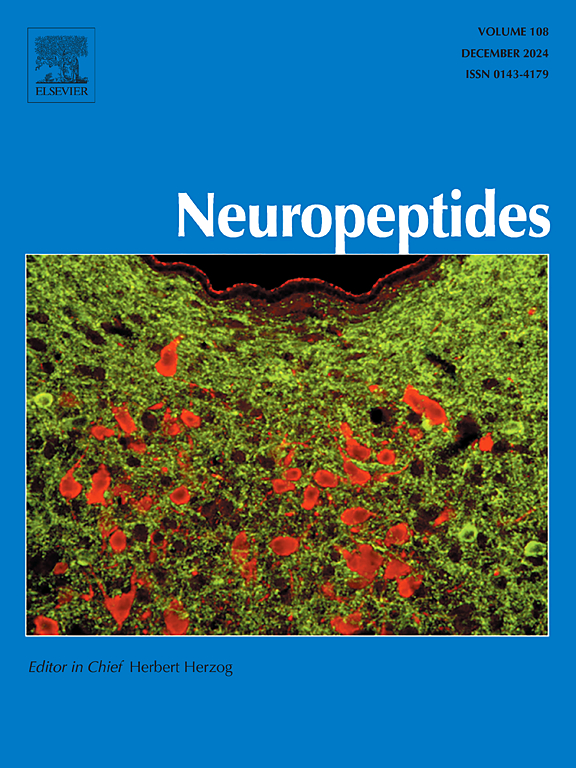FMRFamide G protein-coupled receptors (GPCR) in the cuttlefish Sepiella japonica: Identification, characterization and expression profile
IF 2.7
3区 医学
Q3 ENDOCRINOLOGY & METABOLISM
引用次数: 0
Abstract
FMRFamide is a ubiquitous neuromodulator in the animal kingdom. Once FMRFamide or similar neuropeptides bind to their G protein-coupled receptors (GPCR), a series of signal transduction events are triggered, thereby mediating various physiological effects. FMRFamide had been reported to be involved in the regulation of sexual maturation in Sepiella japonica. In this research, the full-length cDNA of FMRFamide G protein-coupled receptor of S. japonica (SjFaGPCR) was cloned. The sequence is 1396 bp long and encodes a protein consisting of 418 amino acid residues, lacking a signal peptide at the N-terminal region. The 3D structure of SjFaGPCR was predicted using Todarodes pacificus rhodopsin as a template, and the result indicated the presence of seven transmembrane regions. Multiple sequence alignments and phylogenetic trees indicated that SjFaGPCR is conserved among invertebrates, and shares highly similar sequence characteristics with other cephalopods. In situ hybridization (ISH) results revealed that significant signals of SjFaGPCR were detected in the central medulla and the granular layer cells of the optic lobe, and were also observed in the supraesophageal and subesophageal masses of the brain. Meanwhile, quantitative real-time PCR (qRT-PCR) results showed that a higher expression level of SjFaGPCR mRNA was detected in the brain and optic lobe of female cuttlefish at stage III and stage VI, and also in the brain (stage V) and optic lobe (stages IV and V) of male cuttlefish than that in other tissues. The co-localization results demonstrated that fluorescence signals of SjFMRFamide and SjFaGPCR were overlapped in HEK293 cells, suggesting a possible interaction between the SjFMRFamide and SjFaGPCR. These findings provide molecular support for further exploring the roles of FMRFamide and FaGPCR in the reproductive regulation of S. japonica.
墨鱼FMRFamide G蛋白偶联受体(GPCR)的鉴定、表征和表达谱。
FMRFamide是动物王国中普遍存在的神经调节剂。一旦FMRFamide或类似的神经肽与其G蛋白偶联受体(GPCR)结合,就会触发一系列信号转导事件,从而介导各种生理效应。据报道,FMRFamide参与了Sepiella japonica的性成熟调节。本研究克隆了粳稻FMRFamide G蛋白偶联受体的全长cDNA (SjFaGPCR)。该序列长1396 bp,编码一个由418个氨基酸残基组成的蛋白,在n端缺失一个信号肽。以太平洋红紫质为模板预测SjFaGPCR的三维结构,结果表明存在7个跨膜区。多重序列比对和系统发育树分析表明,SjFaGPCR在无脊椎动物中具有保守性,与其他头足类动物具有高度相似的序列特征。原位杂交(ISH)结果显示,在中央髓质和视叶颗粒层细胞中检测到显著的SjFaGPCR信号,在脑食管上和食管下肿物中也观察到。同时,实时荧光定量PCR (qRT-PCR)结果显示,SjFaGPCR mRNA在III期和VI期雌性墨鱼的大脑和视叶,以及雄性墨鱼的大脑(V期)和视叶(IV期和V期)中的表达水平高于其他组织。共定位结果表明,SjFMRFamide和SjFaGPCR的荧光信号在HEK293细胞中存在重叠,提示SjFMRFamide和SjFaGPCR可能存在相互作用。这些发现为进一步探索FMRFamide和FaGPCR在粳稻生殖调控中的作用提供了分子支持。
本文章由计算机程序翻译,如有差异,请以英文原文为准。
求助全文
约1分钟内获得全文
求助全文
来源期刊

Neuropeptides
医学-内分泌学与代谢
CiteScore
5.40
自引率
6.90%
发文量
55
审稿时长
>12 weeks
期刊介绍:
The aim of Neuropeptides is the rapid publication of original research and review articles, dealing with the structure, distribution, actions and functions of peptides in the central and peripheral nervous systems. The explosion of research activity in this field has led to the identification of numerous naturally occurring endogenous peptides which act as neurotransmitters, neuromodulators, or trophic factors, to mediate nervous system functions. Increasing numbers of non-peptide ligands of neuropeptide receptors have been developed, which act as agonists or antagonists in peptidergic systems.
The journal provides a unique opportunity of integrating the many disciplines involved in all neuropeptide research. The journal publishes articles on all aspects of the neuropeptide field, with particular emphasis on gene regulation of peptide expression, peptide receptor subtypes, transgenic and knockout mice with mutations in genes for neuropeptides and peptide receptors, neuroanatomy, physiology, behaviour, neurotrophic factors, preclinical drug evaluation, clinical studies, and clinical trials.
 求助内容:
求助内容: 应助结果提醒方式:
应助结果提醒方式:


